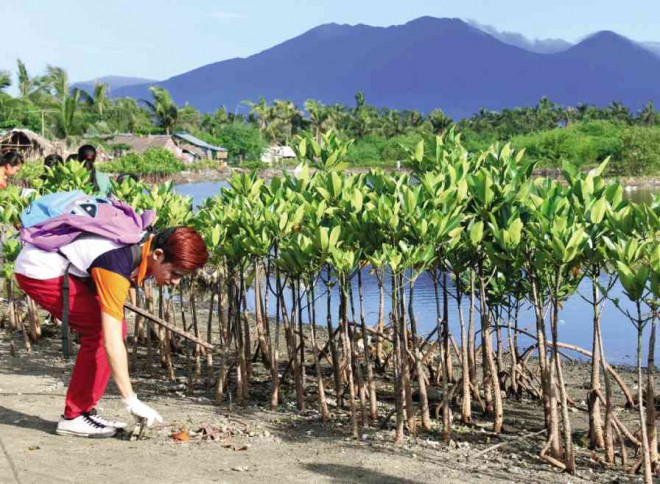
VOLUNTEERS pick up trash in the mangrove area of the village of Dalahican in Lucena City fronting Tayabas Bay. PHOTO COURTESY OF QUEZON PIO
The panorama of mangroves growing along the vast coastline of Quezon province is also serving as a defense barrier from trash that used to swamp the beaches and riverbanks.
“The growing mangroves act as fine-tooth comb that prevents assorted trash coming from the sea to settle on the beach,” Manny Calayag, deputy head of the Quezon-Environment and Natural Resources Office (Quezon-Enro), said in a phone interview.
Mangrove forests, also known as the “rainforests of the sea,” are an important part of the marine ecosystem as the roots of the trees provide shelter for marine life while their fallen leaves provide food for fish and other marine animals.
Speaking from the sidelines of a multisectoral coastal cleanup held in the village of Dalahican in Lucena City on Friday, Calayag said similar events were held in other parts of the province.
Some of the mangrove growing sites have trees that are now over five feet high, he said. He attributed the growth to the coastal villagers, most of them fishermen who take care of the trees.
Since most of the mangroves are robust enough to withstand the waves carrying plastic wrappers and bottles, Styrofoam containers, discarded fishing gear and other garbage washed ashore by the tide, coastal cleaners now have an easy time picking up the litter, Calayag said.
In June 2012, Gov. David Suarez led the mass planting of more than 2 million mangrove propagules in one day in 163 other villages dotting the province’s 1,066-kilometer coastline in a project dubbed Quezon’s 2 in 1.
Thirty-four of Quezon’s 42 towns are coastal—17 along Lamon Bay in the Pacific Ocean, 12 off the Tayabas Bay facing the China Sea and five along the Ragay Gulf.
Janet Geneblazo-Buelo, provincial public information officer, said students, government employees, members of nongovernment groups, villagers and volunteers joined last week’s coastal cleanup in Dalahican. They carried rakes, spades and sacks for trash collection.
After picking up the litter along the beach, they concentrated on the vast mangrove area and were awed by the sight of growing mangroves in a place where mountains of trash once stood.
Suarez has initiated a partnership with the Department of Environment and Natural Resources in the maintenance of the mangrove experimental forest in Pagbilao town, according to Buelo.
Quoting reports from last week’s cleanup, Calayag lamented that some urban residents still lacked the dedication to keep their areas free from garbage compared with those in the rural areas. “We still find modern-day trash like disposable diapers in urban beaches,” he said.
He maintained that the coastal cleanup should not only be a one-day annual event but yearlong.